The Cambridge History of Japan, Vol. 1: Ancient Japan
Подождите немного. Документ загружается.

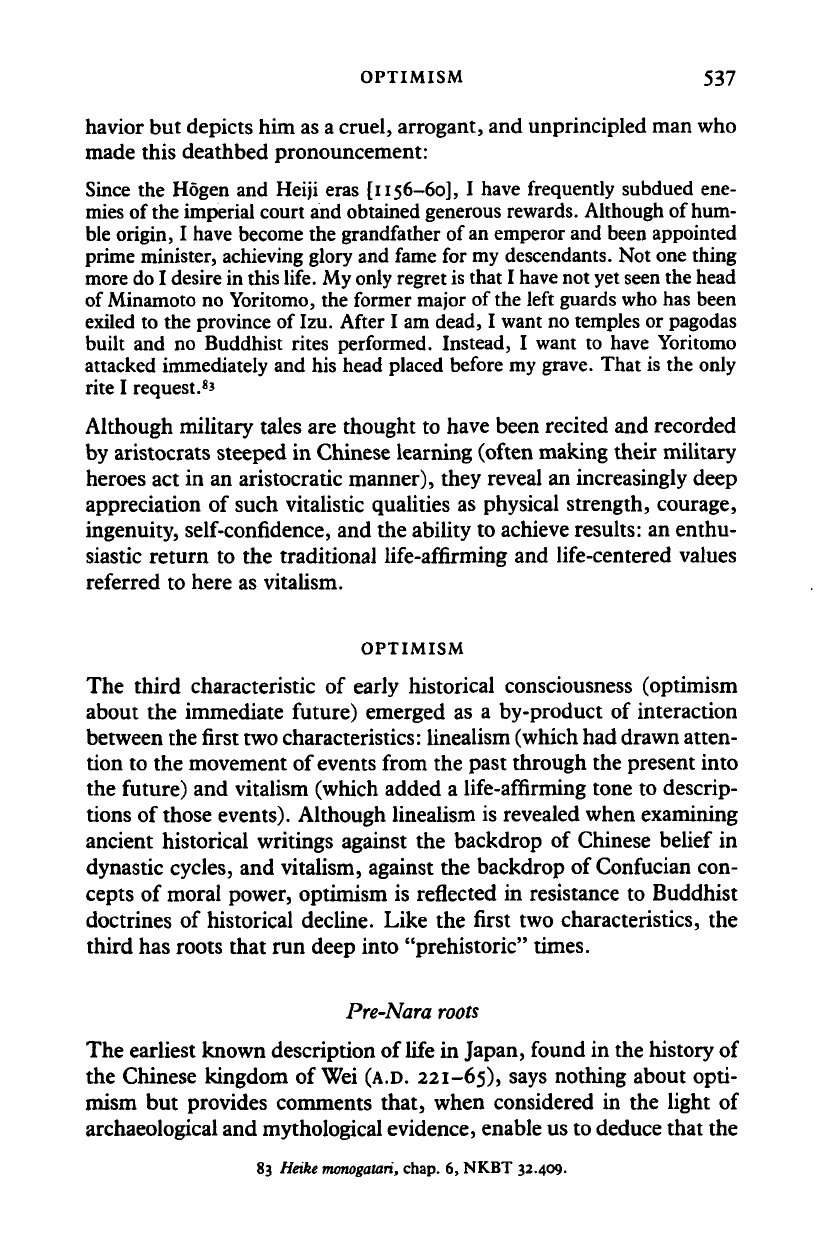
OPTIMISM 537
havior but depicts him as a cruel, arrogant, and unprincipled man who
made this deathbed pronouncement:
Since the Hogen and Heiji eras [1156-60], I have frequently subdued ene-
mies of
the
imperial court and obtained generous rewards. Although of hum-
ble origin, I have become the grandfather of
an
emperor and been appointed
prime minister, achieving glory and fame for my descendants. Not one thing
more do I desire in this life. My only regret is that I have not yet seen the head
of Minamoto no Yoritomo, the former major of the left guards who has been
exiled to the province of Izu. After I am dead, I want no temples or pagodas
built and no Buddhist rites performed. Instead, I want to have Yoritomo
attacked immediately and his head placed before my grave. That is the only
rite I request.
8
'
Although military tales are thought to have been recited and recorded
by aristocrats steeped in Chinese learning (often making their military
heroes act in an aristocratic manner), they reveal an increasingly deep
appreciation of such vitalistic qualities as physical strength, courage,
ingenuity, self-confidence, and the ability to achieve results: an enthu-
siastic return to the traditional life-affirming and life-centered values
referred to here as vitalism.
OPTIMISM
The third characteristic of early historical consciousness (optimism
about the immediate future) emerged as a by-product of interaction
between the first two characteristics: linealism (which had drawn atten-
tion to the movement of events from the past through the present into
the future) and vitalism (which added a life-affirming tone to descrip-
tions of those events). Although linealism is revealed when examining
ancient historical writings against the backdrop of Chinese belief in
dynastic cycles, and vitalism, against the backdrop of Confucian con-
cepts of moral power, optimism is reflected in resistance to Buddhist
doctrines of historical decline. Like the first two characteristics, the
third has roots that run deep into "prehistoric" times.
Pre-Nara
roots
The earliest known description of life in Japan, found in the history of
the Chinese kingdom of
Wei
(A.D.
221-65), says nothing about opti-
mism but provides comments that, when considered in the light of
archaeological and mythological evidence, enable us to deduce that the
83 Heike
monogatari,
chap. 6, NKBT 32.409.
Cambridge Histories Online © Cambridge University Press, 2008
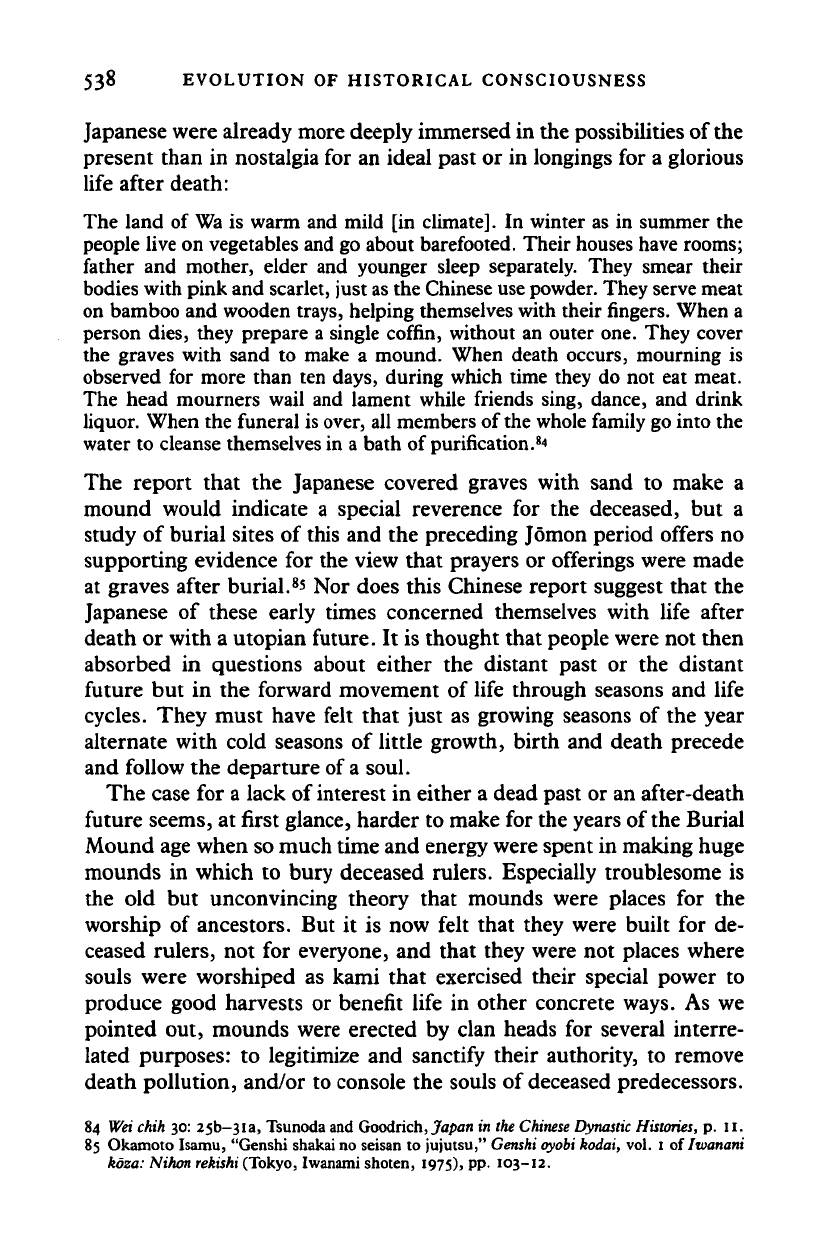
538 EVOLUTION OF HISTORICAL CONSCIOUSNESS
Japanese were already more deeply immersed in the possibilities of the
present than in nostalgia for an ideal past or in longings for a glorious
life after death:
The land of Wa is warm and mild [in climate]. In winter as in summer the
people live on vegetables and go about barefooted. Their houses have rooms;
father and mother, elder and younger sleep separately. They smear their
bodies with pink and scarlet, just as the Chinese use powder. They serve meat
on bamboo and wooden trays, helping themselves with their fingers. When a
person dies, they prepare a single coffin, without an outer one. They cover
the graves with sand to make a mound. When death occurs, mourning is
observed for more than ten days, during which time they do not eat meat.
The head mourners wail and lament while friends sing, dance, and drink
liquor. When the funeral is over, all members of the whole family go into the
water to cleanse themselves in a bath of purification.
8
*
The report that the Japanese covered graves with sand to make a
mound would indicate a special reverence for the deceased, but a
study of burial sites of this and the preceding Jomon period offers no
supporting evidence for the view that prayers or offerings were made
at graves after burial.
8
s Nor does this Chinese report suggest that the
Japanese of these early times concerned themselves with life after
death or with a Utopian future. It is thought that people were not then
absorbed in questions about either the distant past or the distant
future but in the forward movement of life through seasons and life
cycles. They must have felt that just as growing seasons of the year
alternate with cold seasons of little growth, birth and death precede
and follow the departure of a soul.
The case for a lack of interest in either a dead past or an after-death
future seems, at first glance, harder to make for the years of the Burial
Mound age when so much time and energy were spent in making huge
mounds in which to bury deceased rulers. Especially troublesome is
the old but unconvincing theory that mounds were places for the
worship of ancestors. But it is now felt that they were built for de-
ceased rulers, not for everyone, and that they were not places where
souls were worshiped as kami that exercised their special power to
produce good harvests or benefit life in other concrete ways. As we
pointed out, mounds were erected by clan heads for several interre-
lated purposes: to legitimize and sanctify their authority, to remove
death pollution, and/or to console the souls of deceased predecessors.
84 Wei chih 30: 25b-3ia, Tsunoda and Goodrich, Japan in the Chinese Dynastic Histories, p. 11.
85 Okamoto Isamu, "Genshi shakai no seisan to jujutsu," Genshi oyobi kodai, vol. 1 of Iwanani
kdza: Nihon rekishi (Tokyo, Iwanami shoten, 1975), pp. 103-12.
Cambridge Histories Online © Cambridge University Press, 2008
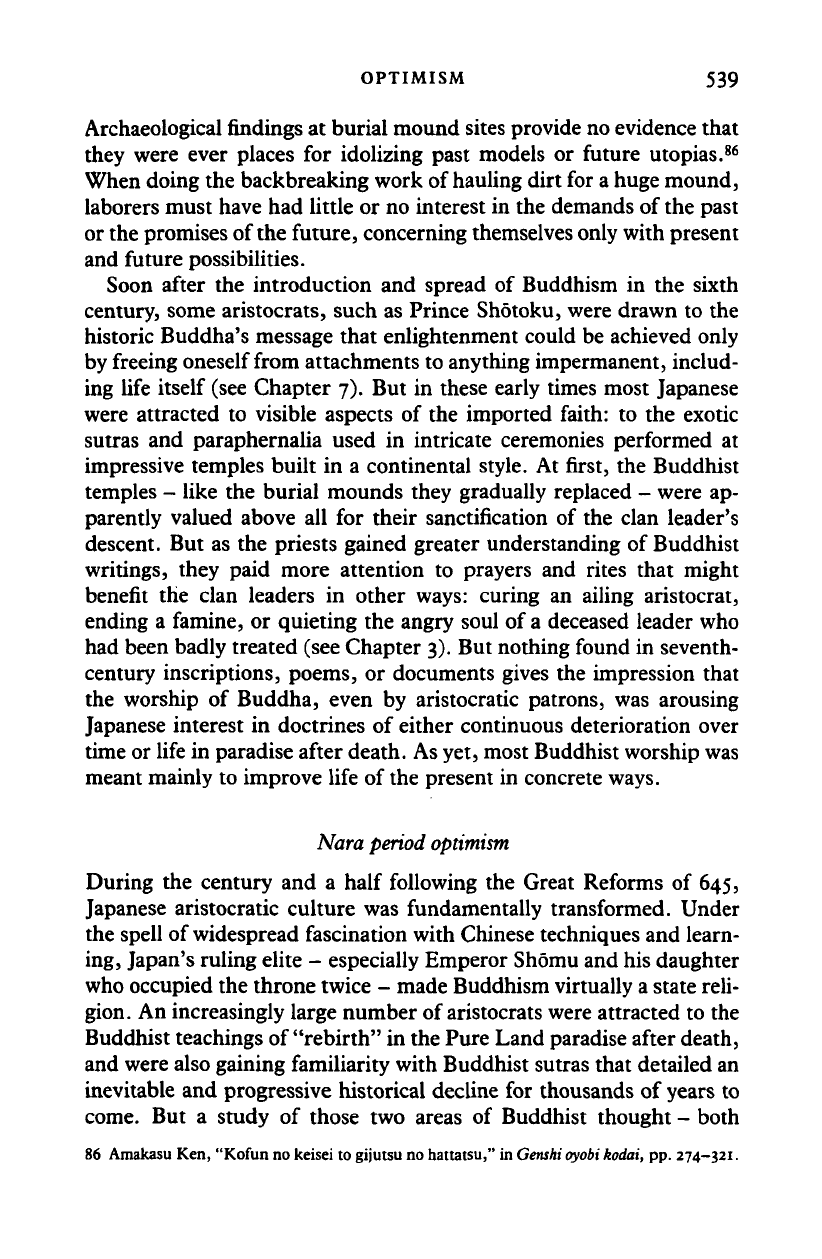
OPTIMISM 539
Archaeological findings at burial mound sites provide no evidence that
they were ever places for idolizing past models or future Utopias.
86
When doing the backbreaking work of hauling dirt for a huge mound,
laborers must have had little or no interest in the demands of the past
or the promises of the future, concerning themselves only with present
and future possibilities.
Soon after the introduction and spread of Buddhism in the sixth
century, some aristocrats, such as Prince Shotoku, were drawn to the
historic Buddha's message that enlightenment could be achieved only
by freeing oneself from attachments to anything impermanent, includ-
ing life itself (see Chapter 7). But in these early times most Japanese
were attracted to visible aspects of the imported faith: to the exotic
sutras and paraphernalia used in intricate ceremonies performed at
impressive temples built in a continental style. At first, the Buddhist
temples - like the burial mounds they gradually replaced - were ap-
parently valued above all for their sanctification of the clan leader's
descent. But as the priests gained greater understanding of Buddhist
writings, they paid more attention to prayers and rites that might
benefit the clan leaders in other ways: curing an ailing aristocrat,
ending a famine, or quieting the angry soul of
a
deceased leader who
had been badly treated (see Chapter
3).
But nothing found in seventh-
century inscriptions, poems, or documents gives the impression that
the worship of Buddha, even by aristocratic patrons, was arousing
Japanese interest in doctrines of either continuous deterioration over
time or life in paradise after death. As yet, most Buddhist worship was
meant mainly to improve life of the present in concrete ways.
Nara period optimism
During the century and a half following the Great Reforms of 645,
Japanese aristocratic culture was fundamentally transformed. Under
the spell of widespread fascination with Chinese techniques and learn-
ing, Japan's ruling elite - especially Emperor Shomu and his daughter
who occupied the throne twice - made Buddhism virtually a state reli-
gion. An increasingly large number of aristocrats were attracted to the
Buddhist teachings of "rebirth" in the Pure Land paradise after death,
and were also gaining familiarity with Buddhist sutras that detailed an
inevitable and progressive historical decline for thousands of years to
come. But a study of those two areas of Buddhist thought - both
86 Amakasu Ken, "Kofun no keisei to gijutsu no battatsu," in Genshi
oyobi
kodai, pp.
274-321.
Cambridge Histories Online © Cambridge University Press, 2008
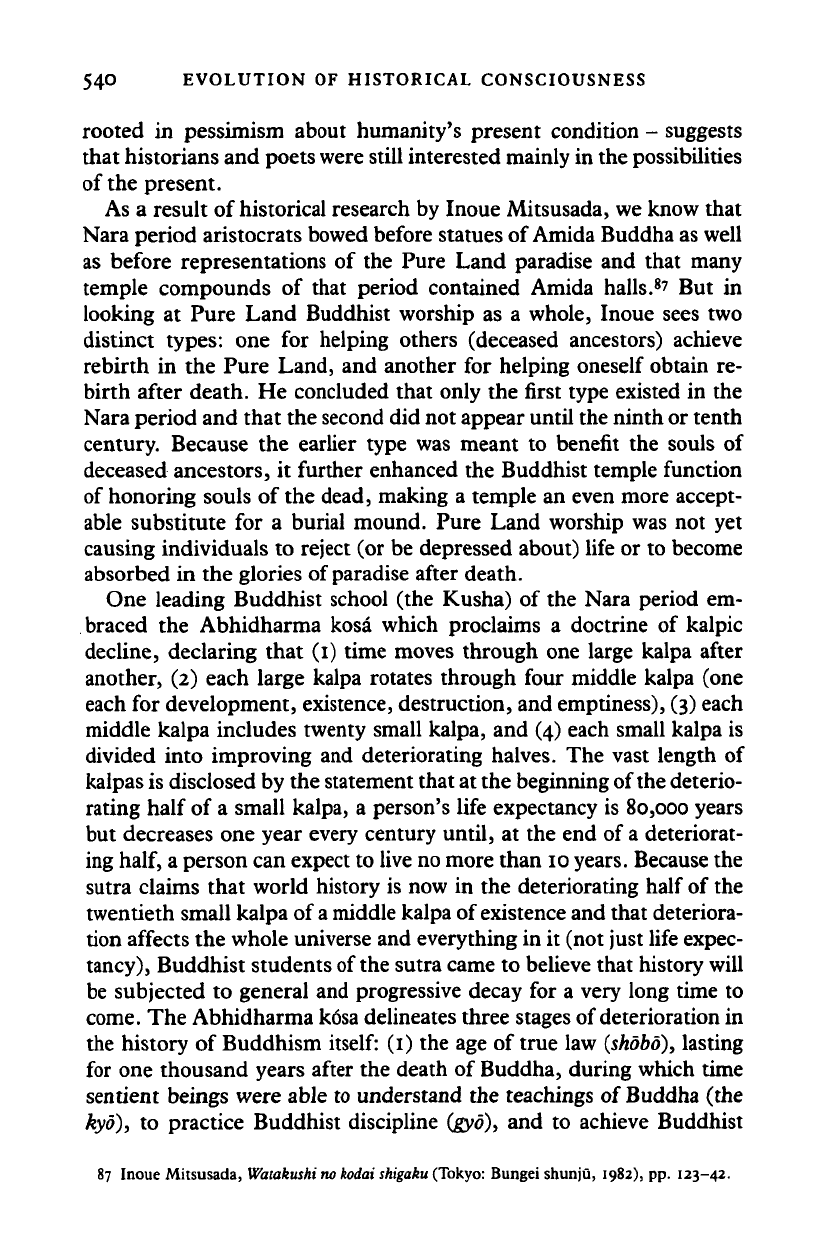
54O EVOLUTION
OF
HISTORICAL CONSCIOUSNESS
rooted
in
pessimism about humanity's present condition
-
suggests
that historians
and
poets were still interested mainly
in
the possibilities
of the present.
As
a
result
of
historical research
by
Inoue Mitsusada, we know that
Nara period aristocrats bowed before statues of Amida Buddha as well
as before representations
of the
Pure Land paradise
and
that many
temple compounds
of
that period contained Amida halls.
87
But in
looking
at
Pure Land Buddhist worship
as a
whole, Inoue sees
two
distinct types:
one for
helping others (deceased ancestors) achieve
rebirth
in the
Pure Land,
and
another
for
helping oneself obtain
re-
birth after death.
He
concluded that only
the
first type existed
in the
Nara period
and
that the second did not appear until the ninth
or
tenth
century. Because
the
earlier type
was
meant
to
benefit
the
souls
of
deceased ancestors,
it
further enhanced
the
Buddhist temple function
of honoring souls
of
the dead, making
a
temple
an
even more accept-
able substitute
for a
burial mound. Pure Land worship
was not yet
causing individuals
to
reject
(or be
depressed about) life
or to
become
absorbed
in the
glories
of
paradise after death.
One leading Buddhist school
(the
Kusha)
of the
Nara period
em-
braced
the
Abhidharma kosa which proclaims
a
doctrine
of
kalpic
decline, declaring that
(i)
time moves through
one
large kalpa after
another,
(2)
each large kalpa rotates through four middle kalpa
(one
each
for
development, existence, destruction,
and
emptiness), (3) each
middle kalpa includes twenty small kalpa,
and (4)
each small kalpa
is
divided into improving
and
deteriorating halves.
The
vast length
of
kalpas is disclosed by the statement that
at
the beginning of the deterio-
rating half
of a
small kalpa,
a
person's life expectancy
is
80,000 years
but decreases
one
year every century until,
at the end of
a
deteriorat-
ing
half, a
person can expect
to
live no more than
10
years.
Because
the
sutra claims that world history
is now in the
deteriorating half
of the
twentieth small kalpa
of
a
middle kalpa of existence and that deteriora-
tion affects
the
whole universe
and
everything
in it (not
just life expec-
tancy),
Buddhist students
of
the sutra came
to
believe that history will
be subjected
to
general
and
progressive decay
for a
very long time
to
come.
The
Abhidharma kosa delineates three stages of deterioration
in
the history
of
Buddhism
itself: (1) the age of
true
law
(shobo),
lasting
for
one
thousand years after
the
death
of
Buddha, during which time
sentient beings were able
to
understand
the
teachings
of
Buddha
(the
kyo),
to
practice Buddhist discipline (gyo),
and to
achieve Buddhist
87 Inoue Mitsusada, Watakushi
no kodai shtgaku
(Tokyo: Bungei shunju, 1982),
pp.
123-42.
Cambridge Histories Online © Cambridge University Press, 2008
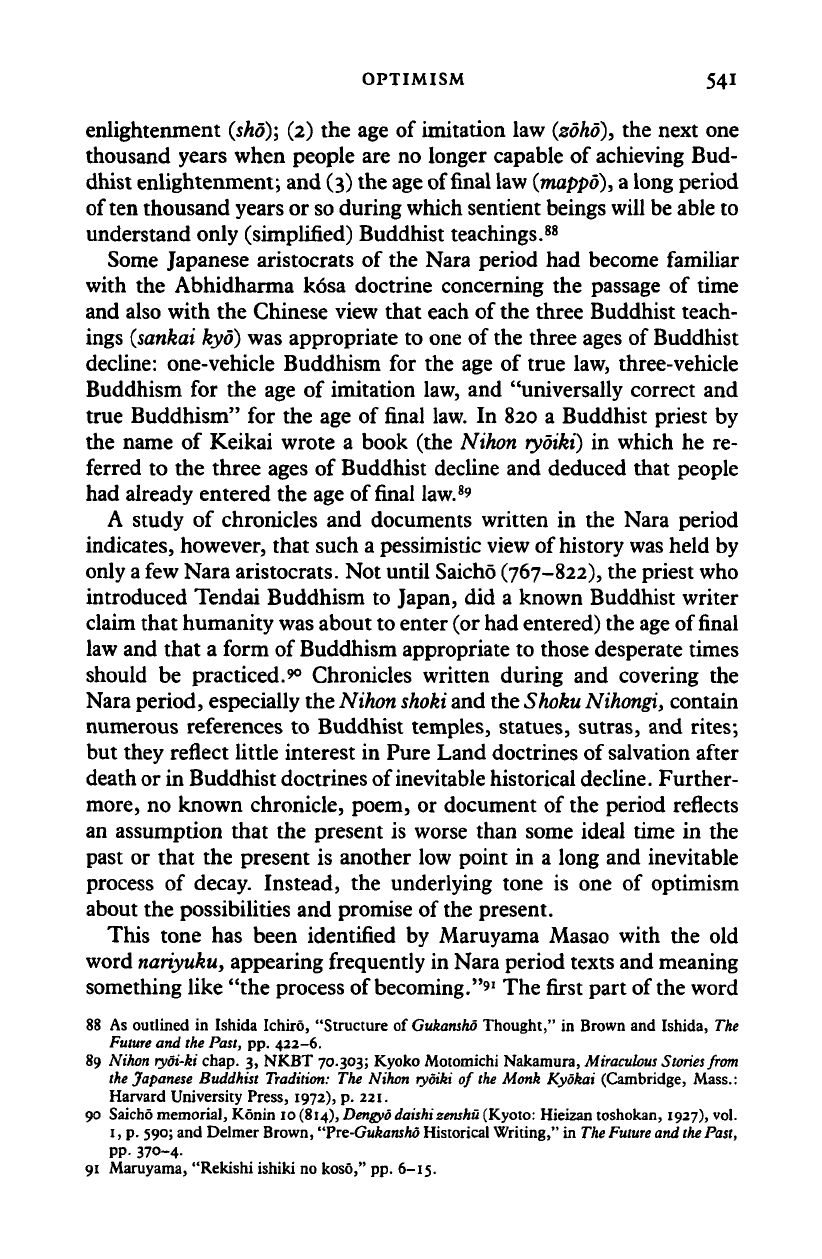
OPTIMISM 541
enlightenment
(sho);
(2) the age of imitation law
(jsoho),
the next one
thousand years when people are no longer capable of achieving Bud-
dhist enlightenment; and (3) the age of
final
law
(mappo),
a long period
often thousand years or so during which sentient beings will be able to
understand only (simplified) Buddhist teachings.
88
Some Japanese aristocrats of the Nara period had become familiar
with the Abhidharma k6sa doctrine concerning the passage of time
and also with the Chinese view that each of the three Buddhist teach-
ings
(sankai
kyo) was appropriate to one of the three ages of Buddhist
decline: one-vehicle Buddhism for the age of true law, three-vehicle
Buddhism for the age of imitation law, and "universally correct and
true Buddhism" for the age of final law. In 820 a Buddhist priest by
the name of Keikai wrote a book (the Nihon
ryoiki)
in which he re-
ferred to the three ages of Buddhist decline and deduced that people
had already entered the age of
final
law.
89
A study of chronicles and documents written in the Nara period
indicates, however, that such a pessimistic view of history was held by
only
a
few Nara aristocrats. Not until Saicho (767-822), the priest who
introduced Tendai Buddhism to Japan, did a known Buddhist writer
claim that humanity was about to enter (or had entered) the age of final
law and that a form of Buddhism appropriate to those desperate times
should be practiced.
90
Chronicles written during and covering the
Nara period, especially the
Nihon shoki
and the
Shoku
Nihongi,
contain
numerous references to Buddhist temples, statues, sutras, and rites;
but they reflect little interest in Pure Land doctrines of salvation after
death or in Buddhist doctrines of inevitable historical
decline.
Further-
more, no known chronicle, poem, or document of the period reflects
an assumption that the present is worse than some ideal time in the
past or that the present is another low point in a long and inevitable
process of decay. Instead, the underlying tone is one of optimism
about the possibilities and promise of the present.
This tone has been identified by Maruyama Masao with the old
word
nariyuku,
appearing frequently in Nara period texts and meaning
something like "the process of
becoming."
91
The first part of the word
88 As outlined in Ishida Ichiro, "Structure of
Gukansho
Thought," in Brown and Ishida, The
Future
and the
Past,
pp. 422-6.
89 Nihon ryoi-ki chap. 3, NKBT 70.303; Kyoko Motomichi Nakamura,
Miraculous
Stories from
the
Japanese Buddhist Tradition: The Nihon ryoiki of
the
Monk Kyokai (Cambridge, Mass.:
Harvard University Press, 1972), p. 221.
90 Saicho memorial, Konin 10 (814),
Dengyo daishi zenshu
(Kyoto: Hieizan toshokan, 1927), vol.
1
>
P- 59°; and Delmer Brown,
"Pre-Gukansho
Historical Writing," in
The Future
and
the
Past,
pp.
370-4.
91 Maruyama, "Rekishi ishiki no kosd," pp. 6-15.
Cambridge Histories Online © Cambridge University Press, 2008
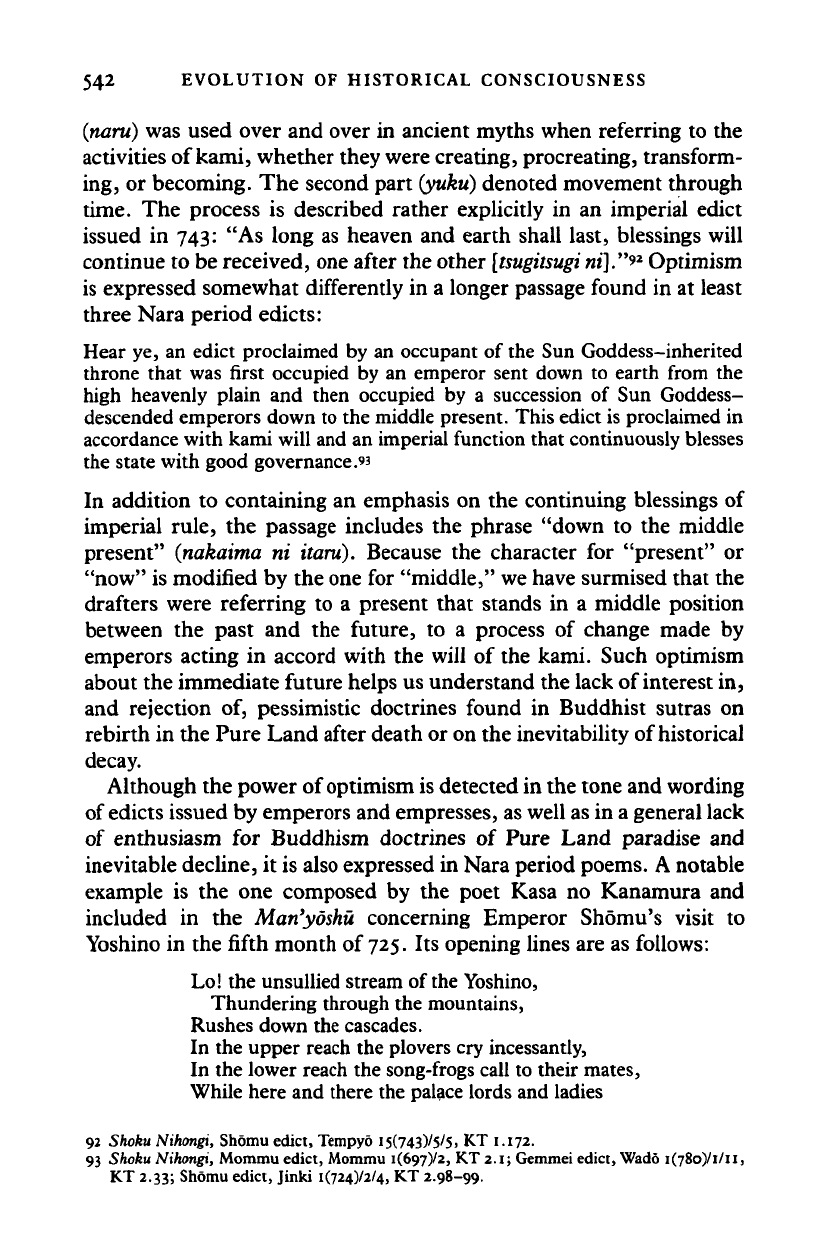
542 EVOLUTION OF HISTORICAL CONSCIOUSNESS
(naru) was used over and over in ancient myths when referring to the
activities of kami, whether they were creating, procreating, transform-
ing, or becoming. The second part (yuku) denoted movement through
time.
The process is described rather explicitly in an imperial edict
issued in 743: "As long as heaven and earth shall last, blessings will
continue to be received, one after the other
[tsugitsugi
HI]."*
2
Optimism
is expressed somewhat differently in a longer passage found in at least
three Nara period edicts:
Hear ye, an edict proclaimed by an occupant of the Sun Goddess-inherited
throne that was first occupied by an emperor sent down to earth from the
high heavenly plain and then occupied by a succession of Sun Goddess-
descended emperors down to the middle present. This edict is proclaimed in
accordance with kami will and an imperial function that continuously blesses
the state with good governance's
In addition to containing an emphasis on the continuing blessings of
imperial rule, the passage includes the phrase "down to the middle
present" (nakaima ni itaru). Because the character for "present" or
"now" is modified by the one for "middle," we have surmised that the
drafters were referring to a present that stands in a middle position
between the past and the future, to a process of change made by
emperors acting in accord with the will of the kami. Such optimism
about the immediate future helps us understand the lack of interest in,
and rejection of, pessimistic doctrines found in Buddhist sutras on
rebirth in the Pure Land after death or on the inevitability of historical
decay.
Although the power of optimism is detected in the tone and wording
of edicts issued by emperors and empresses, as well as in a general lack
of enthusiasm for Buddhism doctrines of Pure Land paradise and
inevitable decline, it is also expressed in Nara period poems. A notable
example is the one composed by the poet Rasa no Kanamura and
included in the Man'yoshu concerning Emperor Shomu's visit to
Yoshino in the fifth month of
725.
Its opening lines are as follows:
Lo!
the unsullied stream of the Yoshino,
Thundering through the mountains,
Rushes down the cascades.
In the upper reach the plovers cry incessantly,
In the lower reach the song-frogs call to their mates,
While here and there the palace lords and ladies
92
Shoku Nihongi, Shomu edict, Tempyo i5(743)/5/5, KT 1.172.
93
Shoku
Nihcmgi,
Mommu edict, Mommu
i(697)/2,
KT
2.1;
Genunei edict, Wado
I(78O)/I/II,
KT
2.33; Shomu edict, Jinki 1(724)72/4, KT 2.98-99.
Cambridge Histories Online © Cambridge University Press, 2008
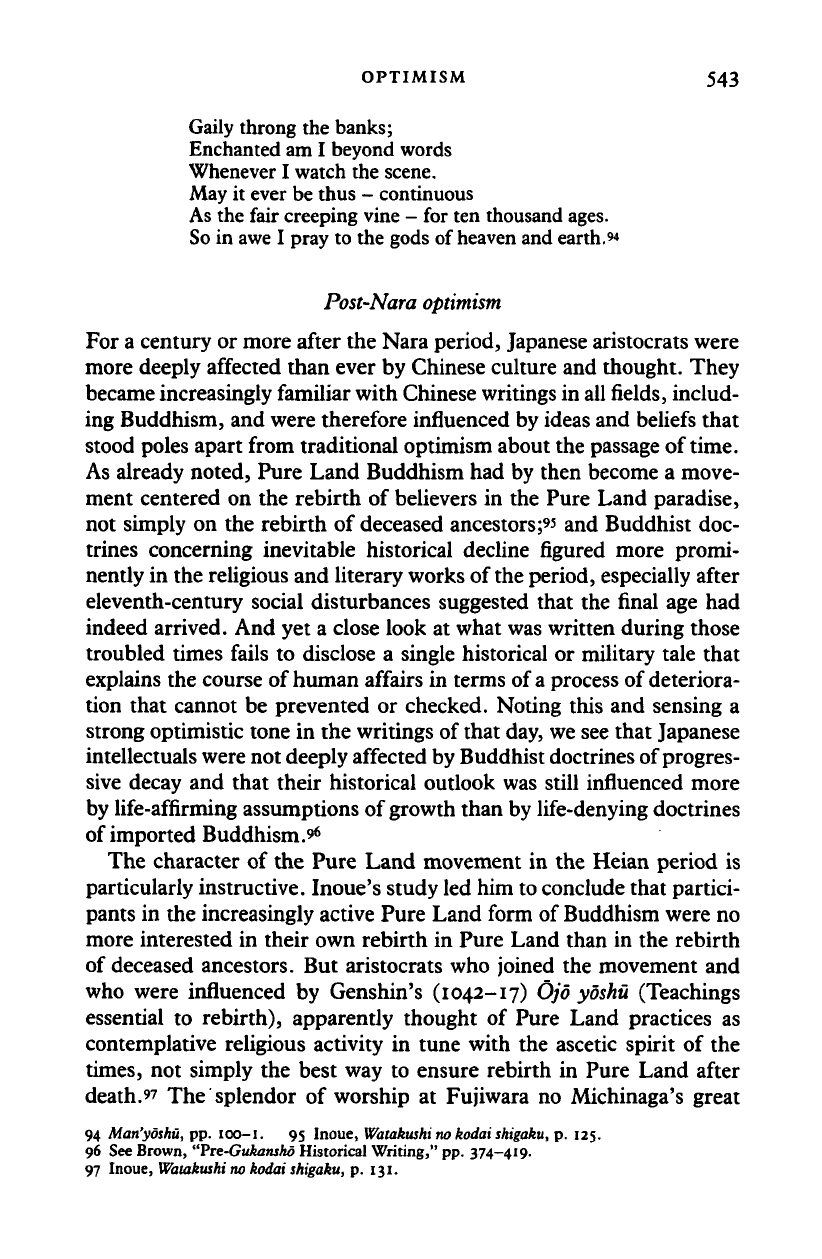
OPTIMISM 543
Gaily throng the banks;
Enchanted am I beyond words
Whenever I watch the scene.
May it ever be thus - continuous
As the fair creeping vine - for ten thousand ages.
So in awe I pray to the gods of heaven and earth.»*
Post-Nara optimism
For a century or more after the Nara period, Japanese aristocrats were
more deeply affected than ever by Chinese culture and thought. They
became increasingly familiar with Chinese writings in all
fields,
includ-
ing Buddhism, and were therefore influenced by ideas and beliefs that
stood poles apart from traditional optimism about the passage of time.
As already noted, Pure Land Buddhism had by then become a move-
ment centered on the rebirth of believers in the Pure Land paradise,
not simply on the rebirth of deceased ancestors;
95
and Buddhist doc-
trines concerning inevitable historical decline figured more promi-
nently in the religious and literary works of the period, especially after
eleventh-century social disturbances suggested that the final age had
indeed arrived. And yet a close look at what was written during those
troubled times fails to disclose a single historical or military tale that
explains the course of human affairs in terms of a process of deteriora-
tion that cannot be prevented or checked. Noting this and sensing a
strong optimistic tone in the writings of that day, we see that Japanese
intellectuals were not deeply affected by Buddhist doctrines of progres-
sive decay and that their historical outlook was still influenced more
by life-affirming assumptions of growth than by life-denying doctrines
of imported Buddhism.*
The character of the Pure Land movement in the Heian period is
particularly instructive. Inoue's study led him to conclude that partici-
pants in the increasingly active Pure Land form of Buddhism were no
more interested in their own rebirth in Pure Land than in the rebirth
of deceased ancestors. But aristocrats who joined the movement and
who were influenced by Genshin's (1042-17)
Ojo yoshu
(Teachings
essential to rebirth), apparently thought of Pure Land practices as
contemplative religious activity in tune with the ascetic spirit of the
times,
not simply the best way to ensure rebirth in Pure Land after
death.97 The splendor of worship at Fujiwara no Michinaga's great
94
Man'yoshu,
pp.
IOO-I.
95 Inoue,
Watakushi
no
kodai
shigaku,
p. 125.
96
See Brown,
"Pre-Gukansko
Historical
Writing,"
pp.
374-419.
97
Inoue,
Watakushi
no
kodai
shigaku,
p. 131.
Cambridge Histories Online © Cambridge University Press, 2008
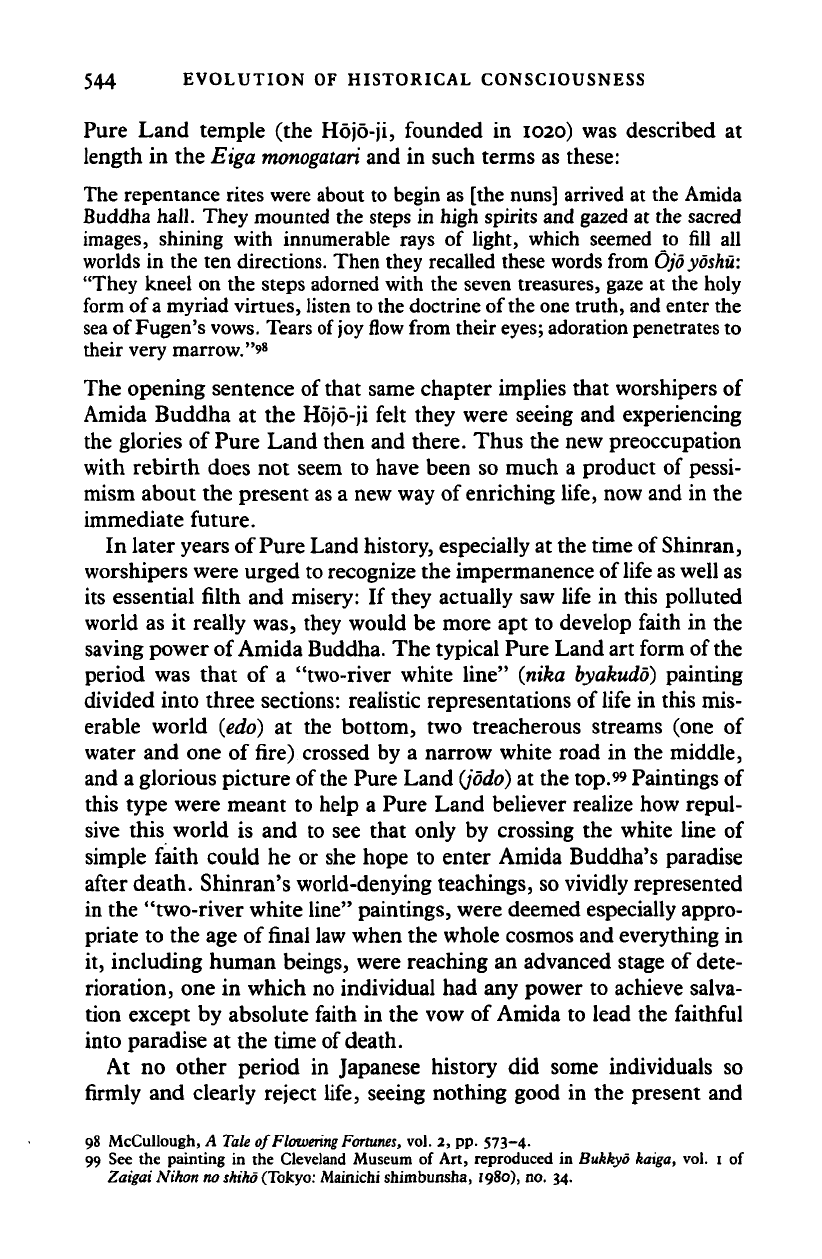
544 EVOLUTION OF HISTORICAL CONSCIOUSNESS
Pure Land temple (the Hojo-ji, founded in 1020) was described at
length in the Eiga
monogatari
and in such terms as these:
The repentance rites were about to begin as [the nuns] arrived at the Amida
Buddha hall. They mounted the steps in high spirits and gazed at the sacred
images, shining with innumerable rays of light, which seemed to fill all
worlds in the ten directions. Then they recalled these words from
Ojoyoshu:
"They kneel on the steps adorned with the seven treasures, gaze at the holy
form of
a
myriad virtues, listen to the doctrine of
the
one truth, and enter the
sea of Fugen's vows. Tears of joy
flow
from their
eyes;
adoration penetrates to
their very marrow. "**
The opening sentence of that same chapter implies that worshipers of
Amida Buddha at the Hojo-ji felt they were seeing and experiencing
the glories of Pure Land then and there. Thus the new preoccupation
with rebirth does not seem to have been so much a product of pessi-
mism about the present as a new way of enriching life, now and in the
immediate future.
In later years of Pure Land history, especially at the time of Shinran,
worshipers were urged to recognize the impermanence of life as well as
its essential filth and misery: If they actually saw life in this polluted
world as it really was, they would be more apt to develop faith in the
saving power of Amida Buddha. The typical Pure Land art form of the
period was that of a "two-river white line" (nika
byakudo)
painting
divided into three sections: realistic representations of life in this mis-
erable world (edo) at the bottom, two treacherous streams (one of
water and one of fire) crossed by a narrow white road in the middle,
and a glorious picture of
the
Pure Land
(jodo)
at the top.99 Paintings of
this type were meant to help a Pure Land believer realize how repul-
sive this world is and to see that only by crossing the white line of
simple faith could he or she hope to enter Amida Buddha's paradise
after death. Shinran's world-denying teachings, so vividly represented
in the "two-river white line" paintings, were deemed especially appro-
priate to the age of final law when the whole cosmos and everything in
it, including human beings, were reaching an advanced stage of dete-
rioration, one in which no individual had any power to achieve salva-
tion except by absolute faith in the vow of Amida to lead the faithful
into paradise at the time of death.
At no other period in Japanese history did some individuals so
firmly and clearly reject life, seeing nothing good in the present and
98 McCullough,
A
Tale
of
Flowering
Fortunes,
vol. 2, pp.
573-4.
99
See the
painting
in the
Cleveland Museum
of Art,
reproduced
in
Bukkyo kaiga,
vol. 1 of
Zaigai Nihon no
Mho
(Tokyo:
Mainichi shimbunsha, 1980),
no. 34.
Cambridge Histories Online © Cambridge University Press, 2008
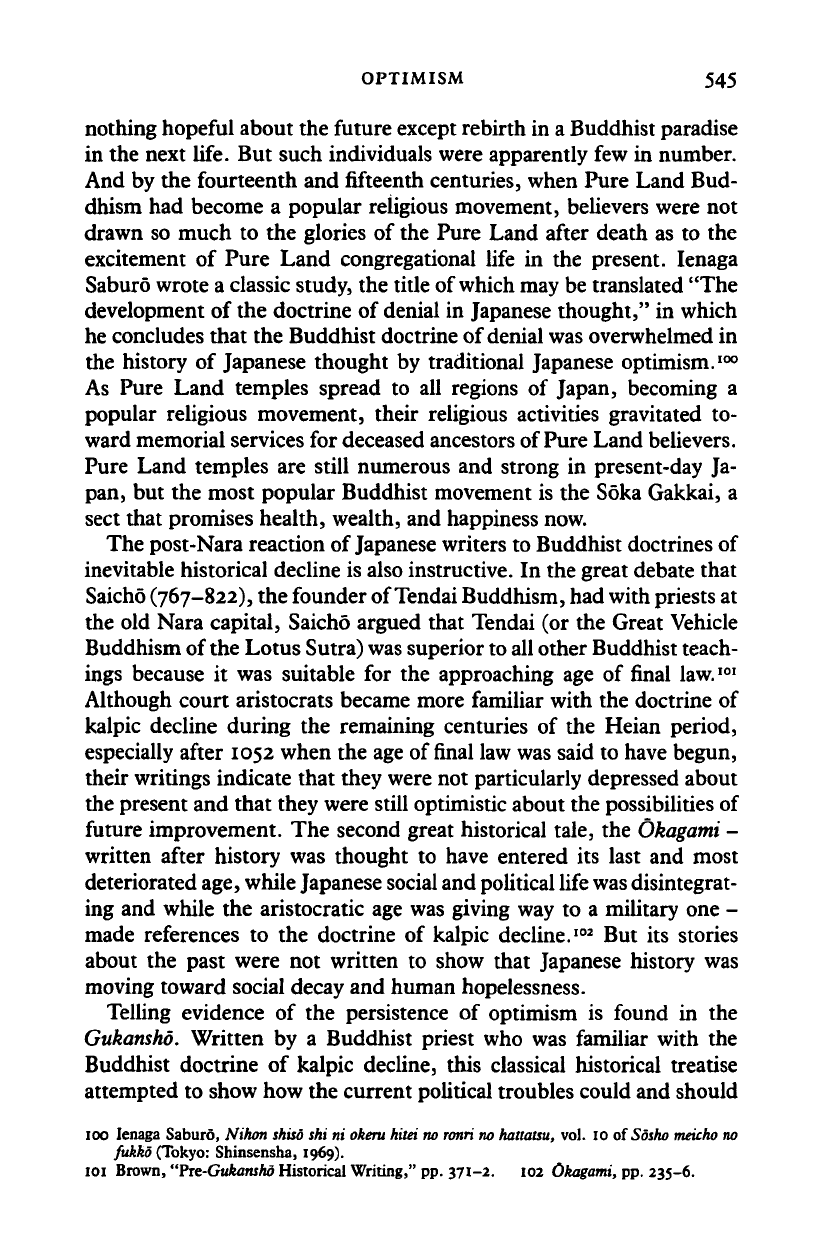
OPTIMISM 545
nothing hopeful about the future except rebirth in a Buddhist paradise
in the next life. But such individuals were apparently few in number.
And by the fourteenth and fifteenth centuries, when Pure Land Bud-
dhism had become a popular religious movement, believers were not
drawn so much to the glories of the Pure Land after death as to the
excitement of Pure Land congregational life in the present. Ienaga
Saburo wrote a classic study, the title of which may be translated "The
development of the doctrine of denial in Japanese thought," in which
he concludes that the Buddhist doctrine of denial was overwhelmed in
the history of Japanese thought by traditional Japanese optimism.
100
As Pure Land temples spread to all regions of Japan, becoming a
popular religious movement, their religious activities gravitated to-
ward memorial services for deceased ancestors of Pure Land believers.
Pure Land temples are still numerous and strong in present-day Ja-
pan, but the most popular Buddhist movement is the Soka Gakkai, a
sect that promises health, wealth, and happiness now.
The post-Nara reaction of Japanese writers to Buddhist doctrines of
inevitable historical decline is also instructive. In the great debate that
Saicho (767-822), the founder of Tendai Buddhism, had with priests at
the old Nara capital, Saicho argued that Tendai (or the Great Vehicle
Buddhism of the Lotus Sutra) was superior to all other Buddhist teach-
ings because it was suitable for the approaching age of final law.
101
Although court aristocrats became more familiar with the doctrine of
kalpic decline during the remaining centuries of the Heian period,
especially after 1052 when the age of final law was said to have begun,
their writings indicate that they were not particularly depressed about
the present and that they were still optimistic about the possibilities of
future improvement. The second great historical tale, the
Okagami
-
written after history was thought to have entered its last and most
deteriorated
age,
while Japanese social and political life
was
disintegrat-
ing and while the aristocratic age was giving way to a military one -
made references to the doctrine of kalpic decline.
102
But its stories
about the past were not written to show that Japanese history was
moving toward social decay and human hopelessness.
Telling evidence of the persistence of optimism is found in the
Gukansho. Written by a Buddhist priest who was familiar with the
Buddhist doctrine of kalpic decline, this classical historical treatise
attempted to show how the current political troubles could and should
100 Ienaga Saburo, Nihon shiso shi ni
okeru
hitei no
ronri
no hattatsu, vol. 10 of
Sosho
macho no
fukko (Tokyo: Shinsensha, 1969).
101 Brown, "Pre-Gukanshd Historical Writing," pp. 371-2. 102 Okagami, pp. 235-6.
Cambridge Histories Online © Cambridge University Press, 2008
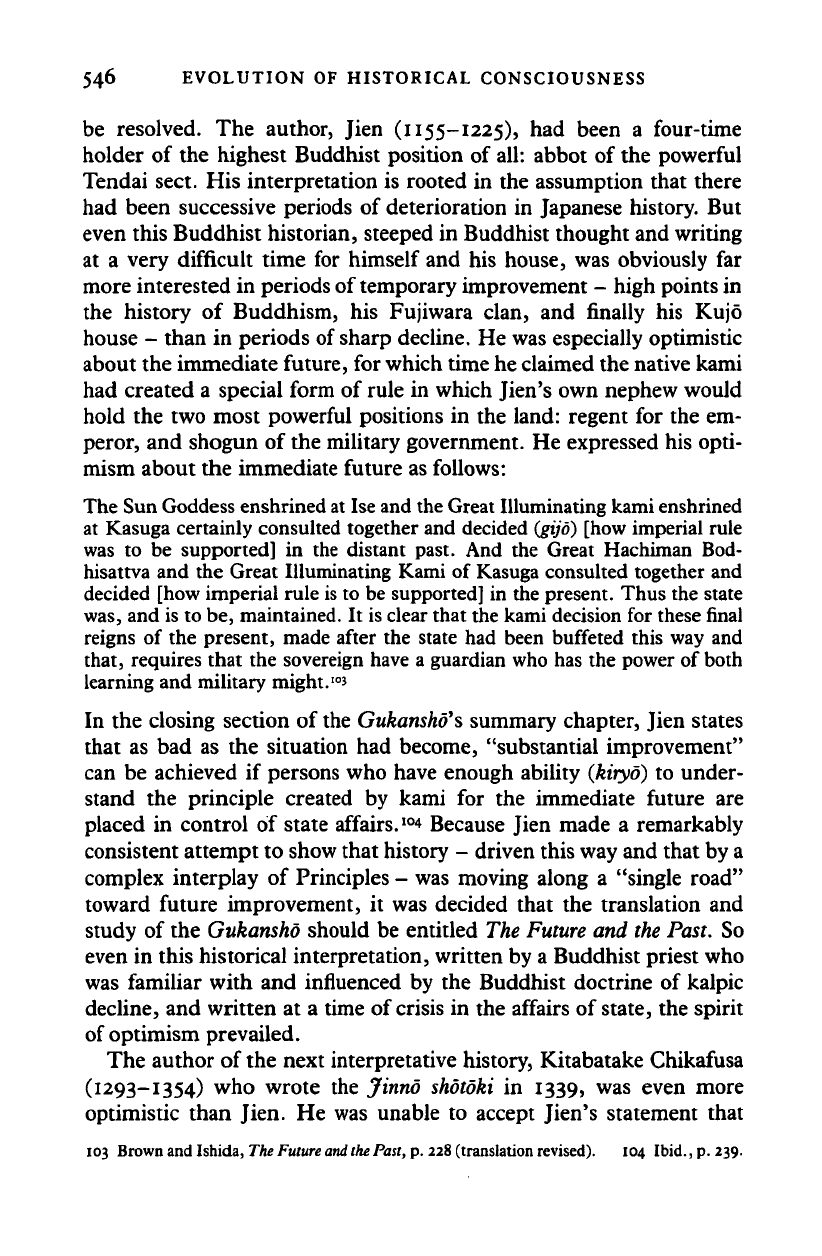
546 EVOLUTION OF HISTORICAL CONSCIOUSNESS
be resolved. The author, Jien (i
155-1225),
had been a four-time
holder of the highest Buddhist position of all: abbot of the powerful
Tendai sect. His interpretation is rooted in the assumption that there
had been successive periods of deterioration in Japanese history. But
even this Buddhist historian, steeped in Buddhist thought and writing
at a very difficult time for himself and his house, was obviously far
more interested in periods of temporary improvement - high points in
the history of Buddhism, his Fujiwara clan, and finally his Kujo
house - than in periods of sharp decline. He was especially optimistic
about the immediate future, for which time he claimed the native kami
had created a special form of rule in which Jien's own nephew would
hold the two most powerful positions in the land: regent for the em-
peror, and shogun of the military government. He expressed his opti-
mism about the immediate future as follows:
The Sun Goddess enshrined at Ise and the Great Illuminating kami enshrined
at Kasuga certainly consulted together and decided
(gijo)
[how imperial rule
was to be supported] in the distant past. And the Great Hachiman Bod-
hisattva and the Great Illuminating Kami of Kasuga consulted together and
decided [how imperial rule is to be supported] in the present. Thus the state
was,
and is to be, maintained. It is clear that the kami decision for these final
reigns of the present, made after the state had been buffeted this way and
that, requires that the sovereign have a guardian who has the power of both
learning and military might.
I0
J
In the closing section of the
Gukansho's
summary chapter, Jien states
that as bad as the situation had become, "substantial improvement"
can be achieved if persons who have enough ability
(kiryo)
to under-
stand the principle created by kami for the immediate future are
placed in control of state affairs.
1O
* Because Jien made a remarkably
consistent attempt to show that history - driven this way and that by a
complex interplay of Principles - was moving along a "single road"
toward future improvement, it was decided that the translation and
study of the
Gukansho
should be entitled The
Future
and
the
Past.
So
even in this historical interpretation, written by a Buddhist priest who
was familiar with and influenced by the Buddhist doctrine of kalpic
decline, and written at a time of
crisis
in the affairs of state, the spirit
of optimism prevailed.
The author of the next interpretative history, Kitabatake Chikafusa
(1293-1354) who wrote the Jinno
shotoki
in 1339, was even more
optimistic than Jien. He was unable to accept Jien's statement that
103 Brown and Ishida, The
Future and the
Past, p. 228 (translation revised). 104 Ibid., p. 239.
Cambridge Histories Online © Cambridge University Press, 2008
